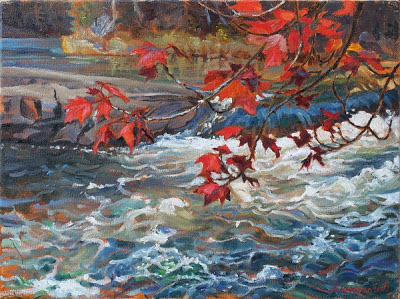Chinese Mystery Snail Habitat (oil on canvas 5 x 7 in.) Sold
19 August finds me sitting on a culvert, painting the narrow watercourse that drains farmers fields in Winchester, Ontario, while Fred and staff of South Nation Conservation dredge Mystery snails the size of walnuts out of the water in nets and by hand.
The water is opaque with suspended clay washed in by yesterday's rain. That makes it quite complex to paint - the shadows and reflections don't do the usual thing. I like the whiskers of tall grasses over the blooming goldenrod and the way the afternoon sun picks out the ripe red fruit on the Apple tree. The spikes of Purple Loosestrife that overhang the water in the foreground are past flowering, but farther down the bank some is still in bloom.
My umbrella shades me on this hot, sultry day, and we're here all afternoon. The painting is loose and bold, with very little fine work, as I'm doing it entirely on site, from the yellow ochre underpainting to the signature. Pure plein air painting, with no finishing in the studio is rather like 'pot luck' - you get what you see on the spot, in the time that you have on the spot!
The Chinese Mystery Snails, Cipangopaludina (or Bellamya) chinensis are remarkable because of their huge size (to 60 mm high, though the ones we are finding are not that large), and uniform dark greenish coloration. Introduced to the Pacific Coast for food by oriental immigrants in the 19th Century, and to many places throughout eastern North America throughout the 20th century as an aquarium snail, these are now common in the Lake Erie and Lake Ontario drainages, around Montreal, and fairly widespread in southwestern Ontario. They have long been known from the Rideau River in Ottawa, and colonies exist in the Ottawa River upstream to Pembroke and the lower Mattawa River. This spring we found them at Blind River, but they hadn't previously been known from the South Nation drainage in eastern Ontario.Last July, a South Nation Conservation team was collecting stream morphology data in a drain in downtown Winchester, and found that the dominant organism in the drain was the Chinese Mystery Snail. This summer, after some discussion, invasive species intern Janet Greenhorn decided to organize a control event, and yesterday and today we sallied forth to the bits of the drain which are accessible. With 3 km at least infested, this is so far just a token effort, but at least we are getting a sense of the abundance of the snails, and the difficulty of scooping them up.
The first thing to note is the black sucking Champlain Sea mire, when it comes to scooping up snails. Yesterday we visited two sites, both of which left Fred groping in the mud to recover his shoes after they'd been wrenched from his feet (the others tended to stand on the shore and prod the watercourse with dipnets, but as a total immersion kind of guy, Fred just waded in and got stuck). Before the torrential rain hit Winchester, there was very little water in the drain where it ran through town, and that was covered by duckweed so the snails could just be felt for by hand, or sorted out of netfulls of mud. The interesting thing to discover was that where the water is low, the Chinese Mystery Snail burrows into the mud. Native snail species found in the mud were only empty shells. Fred's fingers found 62 snails per square metre in the mud.
At today's site, thanks to yesterday's storm, what our team has to work in is half a metre of totally clay-opaque water, and it was decided that in future, visits should be made to different spots on the drain, in different seasons, to try to find it running clear, with snails visible on the bottom, as it was when SNC staff first discovered the Mystery Snails in July 2010.
Fred will measure the 200 or so snails that were collected, and after keeping them in clear water for a week, we'll try out some of the recipes he's found on the web.




this site is Henderson Creek, 1.4 km S o the centre of Winchester, 45.08178N 75.35158W. I took 41 Mystery Snails, mostly at the bases of vegetation on the sides of the ditch, fewer on the muddy open bottom. The sample included Ludwigia palustris (Marsh Purslane) stems (the conspicuous emergent vegetation, though not covering much of the surface) and Sorbus (Mountain Ash) fruits. Only 2 were taken by gunging into the culvert with the net. Edges of the shells were uncalcified, showing that this is a season o active growth.
ReplyDeleteThe size of the snails averaged 22.5mm (8.2mm - 44.3mm, st. dev. =7.46), and no tiny newborns were included in the sample.
The other snail species found was Helisoma trivolvus (Larger Eastern Ramshorn), 21 living snails, averaging 16.68mm (13.6mm - 22.5mm, st. dev. =2.22mm). There were also a few shells of Stagnicola & Gyraulus.
A few Umbra limi (Central Mudminnow) were the only fish; the SNC team found 2 little Orconectes virilis (Blueclaw Crayfish), Leeches, and Water Bugs.
The grassy banks of the ditch supported fairly common Lythrum salicaria (Purple Loosestrife), all with leaves heavily perforated by the nibbling of the Galeruclla Beetles that have been introduced to control their abundance.